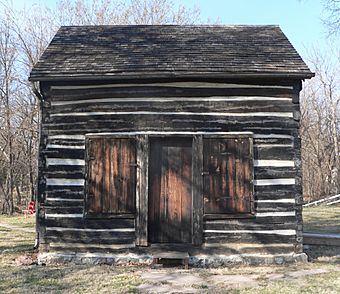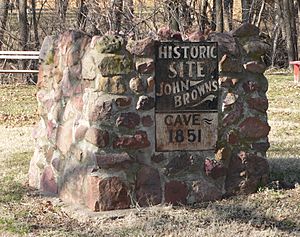Mayhew Cabin facts for kids
Quick facts for kids |
|
|
Mayhew Cabin
|
|

Front (south) of Mayhew Cabin.
|
|
| Location | 2012 4th Corso, Nebraska City, Nebraska |
|---|---|
| Area | less than 1 acre (0.40 ha) |
| NRHP reference No. | 11000013 |
| Added to NRHP | February 11, 2011 |
The Mayhew Cabin (also known as John Brown's Cave) in Nebraska City, Nebraska, is a very important historical place. It is the only site in Nebraska officially recognized by the National Park Service as part of the Underground Railroad. This means it was a safe place for enslaved people seeking freedom.
Contents
What is the Mayhew Cabin?
The Mayhew Cabin is officially called the Mayhew Cabin & Historic Village. It is a special landmark because it was part of the Underground Railroad. The Underground Railroad was not a real railroad. It was a secret network of safe houses and routes. These routes helped enslaved African Americans escape to freedom in the northern states or Canada.
A Look Back: The Cabin's History
Who Built the Cabin?
The Mayhew Cabin was built in 1855. It was built by Allen and Barbara Mayhew. They had moved to Nebraska in 1854. Barbara Mayhew's younger brother, John Henry Kagi, came to live with them in 1855. Kagi had studied law and strongly believed that slavery was wrong.
By 1856, Kagi moved to Kansas Territory. There, he became a close friend and helper of a famous abolitionist named John Brown. An abolitionist was someone who wanted to end slavery completely.
John Brown and the Fight Against Slavery
John Kagi became John Brown's most trusted helper. Brown believed that slavery would not end without a fight. For many years, Brown had a plan to end slavery forever. His plan involved a raid on a weapons storage place in Harper's Ferry, Virginia. He hoped to get weapons to enslaved people. They would then fight for their freedom. After gaining freedom, they would create a peaceful community.
Before this big plan, Brown, Kagi, and their followers were involved in anti-slavery efforts in "Bleeding Kansas." This was a time when there was a lot of violence between people who supported slavery and those who opposed it in Kansas.
A Dangerous Journey to Freedom
In December 1858, John Brown and his group helped a slave named Jim Daniels. They rode into Missouri from Kansas. Their goal was to free Daniels and other enslaved people. They wanted to take them all the way to Canada, where they would be free.
The group split into two. Brown's group freed the Daniels family first. This family included Jim, his pregnant wife, and their two children. They also freed another enslaved man named Sam Harper. Brown's group then freed Sam Harper's mother, his younger sisters, and brother.
At the same time, Kagi's group freed another enslaved person named Jane. The two groups then met up. They headed back to Kansas with eleven people who were now free. For weeks, these escaping people were hidden. They received help at different places in northeast Kansas. Mrs. Daniels even gave birth to a son during this time. They named him after John Brown.
Finding Safety at Mayhew Cabin
In early 1859, the group of twelve people traveled north through Nebraska. In February 1859, they stayed at Barbara Mayhew's cabin. This was John Kagi's sister's home. An armed group of people, called a posse, was chasing them. Despite the posse trying to capture John Kagi at his sister's cabin, the group made it safely across the river into Iowa.
Finally, on March 12, 1859, they reached freedom in Windsor, Ontario, Canada. The twelve people included the eleven who had escaped slavery. Plus, there was the baby born during their journey. They were from three families: the Harper family, the Daniels family, and one unrelated man.
The Cabin's Journey Through Time
The Mayhew Cabin was built in 1855. It was made from hand-cut cottonwood trees. The Mayhew family lived there until 1864. After that, the cabin and land were sold many times.
In 1937, the owner, Edward Bartling, had the cabin moved. This was to save it from a highway project. During the move, the cabin was fixed up. Its original 1850s look was uncovered. This old-fashioned look helped Bartling open the cabin to the public. He wanted to make his property a tourist park.
Bartling also had a cave built under the cabin. This was to help tell the story of the Mayhew family's connection to the Underground Railroad. The cave has a cellar and tunnels. It also has sleeping areas and a tunnel that leads to a nearby ravine. The cabin was open to visitors from 1938 to 2002. It was known as the John Brown's Cave tourist attraction.
The Mayhew Cabin was added to the U.S. National Register of Historic Places on February 11, 2010. This means it is a very important historical site.
Restoration and What You Can See Today
In 2005, the Mayhew Cabin was restored. A non-profit group now runs the site. In 2010, this group got a new museum space. It is just west of the Mayhew Cabin.
The foundation also takes care of an old Mt. Zion AME Church on the site. This church was one of the first black congregations (groups of church members) established west of the Missouri River.
See also



